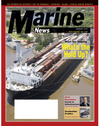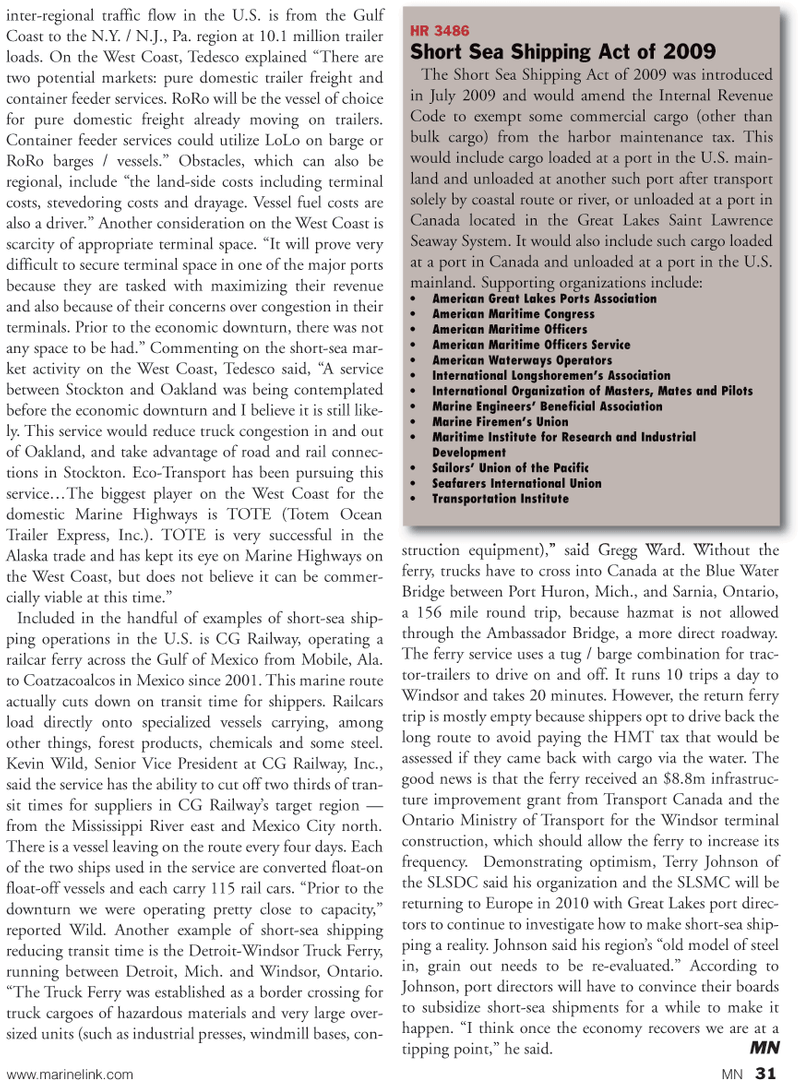
Page 31: of Marine News Magazine (January 2, 2010)
Read this page in Pdf, Flash or Html5 edition of January 2, 2010 Marine News Magazine
inter-regional traffic flow in the U.S. is from the Gulf
Coast to the N.Y. / N.J., Pa. region at 10.1 million trailer loads. On the West Coast, Tedesco explained “There are two potential markets: pure domestic trailer freight and container feeder services. RoRo will be the vessel of choice for pure domestic freight already moving on trailers.
Container feeder services could utilize LoLo on barge or
RoRo barges / vessels.” Obstacles, which can also be regional, include “the land-side costs including terminal costs, stevedoring costs and drayage. Vessel fuel costs are also a driver.” Another consideration on the West Coast is scarcity of appropriate terminal space. “It will prove very difficult to secure terminal space in one of the major ports because they are tasked with maximizing their revenue and also because of their concerns over congestion in their terminals. Prior to the economic downturn, there was not any space to be had.” Commenting on the short-sea mar- ket activity on the West Coast, Tedesco said, “A service between Stockton and Oakland was being contemplated before the economic downturn and I believe it is still like- ly. This service would reduce truck congestion in and out of Oakland, and take advantage of road and rail connec- tions in Stockton. Eco-Transport has been pursuing this service…. The biggest player on the West Coast for the domestic Marine Highways is TOTE (Totem Ocean
Trailer Express, Inc.). TOTE is very successful in the
Alaska trade and has kept its eye on Marine Highways on the West Coast, but does not believe it can be commer- cially viable at this time.”
Included in the handful of examples of short-sea ship- ping operations in the U.S. is CG Railway, operating a railcar ferry across the Gulf of Mexico from Mobile, Ala. to Coatzacoalcos in Mexico since 2001. This marine route actually cuts down on transit time for shippers. Railcars load directly onto specialized vessels carrying, among other things, forest products, chemicals and some steel.
Kevin Wild, Senior Vice President at CG Railway, Inc., said the service has the ability to cut off two thirds of tran- sit times for suppliers in CG Railway’s target region — from the Mississippi River east and Mexico City north.
There is a vessel leaving on the route every four days. Each of the two ships used in the service are converted float-on float-off vessels and each carry 115 rail cars. “Prior to the downturn we were operating pretty close to capacity,” reported Wild. Another example of short-sea shipping reducing transit time is the Detroit-Windsor Truck Ferry, running between Detroit, Mich. and Windsor, Ontario. “The Truck Ferry was established as a border crossing for truck cargoes of hazardous materials and very large over- sized units (such as industrial presses, windmill bases, con- struction equipment),” said Gregg Ward. Without the ferry, trucks have to cross into Canada at the Blue Water
Bridge between Port Huron, Mich., and Sarnia, Ontario, a 156 mile round trip, because hazmat is not allowed through the Ambassador Bridge, a more direct roadway.
The ferry service uses a tug / barge combination for trac- tor-trailers to drive on and off. It runs 10 trips a day to
Windsor and takes 20 minutes. However, the return ferry trip is mostly empty because shippers opt to drive back the long route to avoid paying the HMT tax that would be assessed if they came back with cargo via the water. The good news is that the ferry received an $8.8m infrastruc- ture improvement grant from Transport Canada and the
Ontario Ministry of Transport for the Windsor terminal construction, which should allow the ferry to increase its frequency. Demonstrating optimism, Terry Johnson of the SLSDC said his organization and the SLSMC will be returning to Europe in 2010 with Great Lakes port direc- tors to continue to investigate how to make short-sea ship- ping a reality. Johnson said his region’s “old model of steel in, grain out needs to be re-evaluated.” According to
Johnson, port directors will have to convince their boards to subsidize short-sea shipments for a while to make it happen. “I think once the economy recovers we are at a tipping point,” he said. MN
HR 3486
Short Sea Shipping Act of 2009
The Short Sea Shipping Act of 2009 was introduced in July 2009 and would amend the Internal Revenue
Code to exempt some commercial cargo (other than bulk cargo) from the harbor maintenance tax. This would include cargo loaded at a port in the U.S. main- land and unloaded at another such port after transport solely by coastal route or river, or unloaded at a port in
Canada located in the Great Lakes Saint Lawrence
Seaway System. It would also include such cargo loaded at a port in Canada and unloaded at a port in the U.S. mainland. Supporting organizations include: • American Great Lakes Ports Association • American Maritime Congress • American Maritime Officers • American Maritime Officers Service • American Waterways Operators • International Longshoremen’s Association • International Organization of Masters, Mates and Pilots • Marine Engineers’ Beneficial Association • Marine Firemen’s Union • Maritime Institute for Research and Industrial
Development • Sailors’ Union of the Pacific • Seafarers International Union • Transportation Institute www.marinelink.com MN 31

 30
30

 32
32
